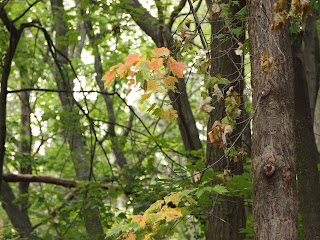 |
| Picture complements of the International Crane Foundation http://www.savingcranes.org/species-field-guide.html |
Final Report from Lightfoot Bay
Sunday - This is the last night at Lightfoot Bay and tonight’s entertainment is spectacular. I had heard about the Sandhill Crane dance but had never seen it in person. Across the bay three cranes dance in a circle, jumping up and down, wings flapping. They danced around each other for five minutes then returned to eating in the reeds. Being large birds, they could be easily watched through my binoculars. Three years ago I encountered these birds for the first time, on my way home from Neebish Island. I was immediately struck by their size and appearance. Later that fall I made a trip to a Jackson area wetland in search of sandhill cranes making their fall migration.
Sandhill cranes are not your typical bird. Long legs and necks, they stand 3-4 feet tall with wingspans extending 6-7 feet wide. Sandhill cranes are a member of the Gruidae bird family and one of only three species of cranes in North America (the other two are the Common also known as Gray Crane and Whooping Crane ).
One of the oldest bird species crane fossils have been found dating back 40-60 million years ago. Despite their ancient history present day world crane populations have been declining, victims of overhunting and loss of habitat. The IUCN (International Union for Conservation of Nature and Natural Resources) list four crane species as either endangered (Grey-crowned Cranes, Whooping Cranes, Red-crowned Cranes) or critically endangered (Siberian Cranes).
Citation:
|
IUCN 2012. IUCN Red List of Threatened Species. Version 2012.1. <www.iucnredlist.org>. Downloaded on 31 August 2012.
|
What I saw on Sunday evening is known as a courting ritual. The dance was a picture of unrestrained joy and to be witness to such a sight was a privilege. I couldn’t have asked for a better going away gift.
Postscript: been trying to find a good video of the dance. This is one of the better videos, thanks birdfreak.com:
http://birdfreak.com/video-wednesday-sandhill-crane-dance/
Postscript: been trying to find a good video of the dance. This is one of the better videos, thanks birdfreak.com:
http://birdfreak.com/video-wednesday-sandhill-crane-dance/

















